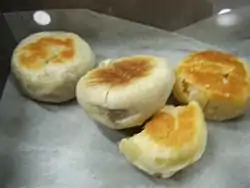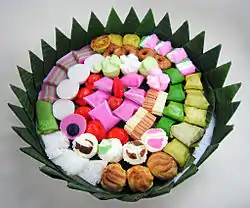Bakpia pathok
Bakpia pathok (Javanese: ꦧꦏ꧀ꦥꦶꦪꦥꦛꦸꦏ꧀, romanized: bakpia pathuk) is a small, round-shaped Chinese-influenced Indonesian sweet roll (bakpia), usually stuffed with mung beans, but have recently come in other fillings as well, e.g. chocolate, durian and cheese. This sweet roll found in Javanese and Chinese Indonesian cuisine. They are one of Yogyakarta's specialties and named after the Pathok suburb where the pastries originated.[1]
 Bakpia pathok | |
| Alternative names | Bakpia pathuk (Javanese) |
|---|---|
| Type | Sweet roll, kue |
| Course | Snack, appetizer, dessert |
| Place of origin | Indonesia |
| Region or state | Pathok, Yogyakarta, Special Region of Yogyakarta |
| Serving temperature | Room temperature |

Bakpia pathok is similar to the larger Indonesian pia, with the only difference being the size. They are commercially packaged in small boxes and sold at many food shops in Yogyakarta; bakpia were influenced by Chinese sweet rolls.[1]
History
It is thought that bakpia pathok was brought to Yogyakarta by a merchant from China named Kwik Sun Kwok in the 1940s. The dish initially had meat fillings and uses pork. Later on, a version with mung bean fillings was developed and this version remains popular to this day. The Pathuk subdistrict in Yogyakarta started producing their version of bakpia in the 1980s, which became the regional standard. To differentiate their products, bakpia pathok makers named their products after their house number (e.g., Bakpia Pathok 21, Bakpia Pathok 13). This practice remains to this day, though newer bakpia pathok makers may use different naming standards.[2]
Ingredients
The dough for bakpia pathok is made out of flour, salt, and coconut oil. Traditionally, bakpia pathok’s filling is a combination of mungbean and sugar.[3] However, modern variants of bakpia pathok often offer fillings with flavors such as chocolate and taro.[4]
See also
References
- A Budi Kurniawan, Erwin E Prasetya (3 January 2014). "Bakpia, Buah Tangan Toleransi dan Akulturasi". Kompas.com (in Indonesian). Retrieved 13 January 2015.
- "Asal-Usul Bakpia, Makanan Khas Jogja Akulturasi Jawa dan Cina". tirto.id (in Indonesian). Retrieved 2021-01-27.
- Masakan & Jajanan Favorit (in Indonesian). Niaga Swadaya. ISBN 978-602-8060-07-3.
- Media, Kompas Cyber. "Bakpia Pathuk Kini Memiliki Varian Rasa Halaman all". KOMPAS.com (in Indonesian). Retrieved 2021-01-27.
